This article illustrates some typical operational amplifier applications. A non-ideal operational amplifier's equivalent circuit has a finite input impedance, a non-zero output impedance, and a finite gain. A real op-amp has a number of non-ideal features as shown in the diagram, but here a simplified schematic notation is used, many details such as device selection and power supply connections are not shown. Operational amplifiers are optimised for use with negative feedback, and this article discusses only negative-feedback applications. When positive feedback is required, a comparator is usually more appropriate.
Practical considerations
Operational amplifiers parameter requirements
In order for a particular device to be used in an application, it must satisfy certain requirements. The operational amplifier must- have large open-loop signal gain (voltage gain of 200,000 is obtained in early integrated circuit exemplars), and
- have input impedance large with respect to values present in the feedback network.
Component specification
Resistors used in practical solid-state op-amp circuits are typically in the kΩ range. Resistors much greater than 1 MΩ cause excessive thermal noise and make the circuit operation susceptible to significant errors due to bias or leakage currents.Input bias currents and input offset
Practical operational amplifiers draw a small current from each of their inputs due to bias requirements (in the case of bipolar junction transistor-based inputs) or leakage (in the case of MOSFET-based inputs).These currents flow through the resistances connected to the inputs and produce small voltage drops across those resistances. Appropriate design of the feedback network can alleviate problems associated with input bias currents and common-mode gain, as explained below. The heuristic rule is to ensure that the impedance "looking out" of each input terminal is identical.
To the extent that the input bias currents do not match, there will be an effective input offset voltage present, which can lead to problems in circuit performance. Many commercial op-amp offerings provide a method for tuning the operational amplifier to balance the inputs (e.g., "offset null" or "balance" pins that can interact with an external voltage source attached to a potentiometer). Alternatively, a tunable external voltage can be added to one of the inputs in order to balance out the offset effect. In cases where a design calls for one input to be short-circuited to ground, that short circuit can be replaced with a variable resistance that can be tuned to mitigate the offset problem.
Operational amplifiers using MOSFET-based input stages have input leakage currents that will be, in many designs, negligible.
Power supply effects
Although power supplies are not indicated in the (simplified) operational amplifier designs below, they are nonetheless present and can be critical in operational amplifier circuit design.Supply noise
Power supply imperfections (e.g., power signal ripple, non-zero source impedance) may lead to noticeable deviations from ideal operational amplifier behavior. For example, operational amplifiers have a specified power supply rejection ratio that indicates how well the output can reject signals that appear on the power supply inputs. Power supply inputs are often noisy in large designs because the power supply is used by nearly every component in the design, and inductance effects prevent current from being instantaneously delivered to every component at once. As a consequence, when a component requires large injections of current (e.g., a digital component that is frequently switching from one state to another), nearby components can experience sagging at their connection to the power supply. This problem can be mitigated with appropriate use of bypass capacitors connected across each power supply pin and ground. When bursts of current are required by a component, the component can bypass the power supply by receiving the current directly from the nearby capacitor (which is then slowly recharged by the power supply).Using power supply currents in the signal path
Additionally, current drawn into the operational amplifier from the power supply can be used as inputs to external circuitry that augment the capabilities of the operational amplifier. For example, an operational amplifier may not be fit for a particular high-gain application because its output would be required to generate signals outside of the safe range generated by the amplifier. In this case, an external push–pull amplifier can be controlled by the current into and out of the operational amplifier. Thus, the operational amplifier may itself operate within its factory specified bounds while still allowing the negative feedback path to include a large output signal well outside of those bounds.Amplifiers
The first example is the differential amplifier, from which many of the other applications can be derived, including the inverting, non-inverting, and summing amplifier, the voltage follower, integrator, differentiator, and gyrator.Differential amplifier (difference amplifier)

Amplifies the difference in voltage between its inputs.
- The name "differential amplifier" must not be confused with the "differentiator", which is also shown on this page.
- The "instrumentation amplifier", which is also shown on this page, is a modification of the differential amplifier that also provides high input impedance.
The special case when the closed-loop gain is unity is a differential follower, with
Inverting amplifier
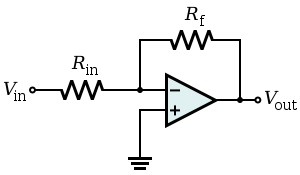
An inverting amplifier is a special case of the differential amplifier in which that circuit's non-inverting input V2 is grounded, and inverting input V1 is identified with Vin above. The closed-loop gain is Rf / Rin, hence
- .
To intuitively see the gain equation above, calculate the current in Rin:
As the negative input of the op-amp acts as a virtual ground, the input impedance of this circuit is equal to Rin.
Non-inverting amplifier

A non-inverting amplifier is a special case of the differential amplifier in which that circuit's inverting input V1 is grounded, and non-inverting input V2 is identified with Vin above, with R1 ≫ R2. Referring to the circuit immediately above,
- .
A mechanical analogy is a class-2 lever, with one terminal of R1 as the fulcrum, at ground potential. Vin is at a length R1 from the fulcrum; Vout is at a length R2 further along. When Vin ascends "above ground", the output Vout rises proportionately with the lever.
The input impedance of the simplified non-inverting amplifier is high:
The feedback loop similarly decreases the output impedance:
Voltage follower (unity buffer amplifier)

Used as a buffer amplifier to eliminate loading effects (e.g., connecting a device with a high source impedance to a device with a low input impedance):
- ;
- (realistically, the differential input impedance of the op-amp itself (1 MΩ to 1 TΩ), multiplied by the open-loop gain of the op-amp).
The input and output impedance are affected by the feedback loop in the same way as the non-inverting amplifier, with B=1.
Summing amplifier
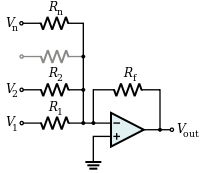
A summing amplifier sums several (weighted) voltages:
- ;
- When , and independent;
- ;
- When ;
- ;
- Output is inverted;
- Input impedance of the nth input is ( is a virtual ground).
Instrumentation amplifier
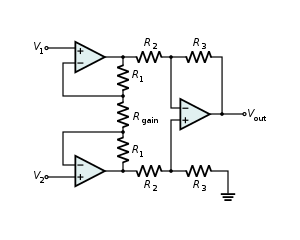
Combines very high input impedance, high common-mode rejection, low DC offset, and other properties used in making very accurate, low-noise measurements
- Is made by adding a non-inverting buffer to each input of the differential amplifier to increase the input impedance.
Oscillators
Wien bridge oscillator

Produces a very low distortion sine wave. Uses negative temperature compensation in the form of a light bulb or diode.
Filters
Operational amplifiers can be used in construction of active filters, providing high-pass, low-pass, band-pass, reject and delay functions. The high input impedance and gain of an op-amp allow straightforward calculation of element values, allowing accurate implementation of any desired filter topology with little concern for the loading effects of stages in the filter or of subsequent stages. However, the frequencies at which active filters can be implemented is limited; when the behavior of the amplifiers departs significantly from the ideal behavior assumed in elementary design of the filters, filter performance is degraded.Comparator
An operational amplifier can, if necessary, be forced to act as a comparator. The smallest difference between the input voltages will be amplified enormously, causing the output to swing to nearly the supply voltage. However, it is usually better to use a dedicated comparator for this purpose, as its output has a higher slew rate and can reach either power supply rail. Some op-amps have clamping diodes on the input that prevent use as a comparator.
Integration and differentiation
Inverting integrator
The integrator is mostly used in analog computers, analog-to-digital converters and wave-shaping circuits.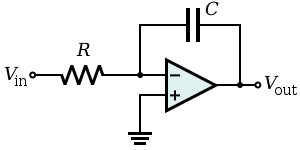
Integrates (and inverts) the input signal Vin(t) over a time interval t, t0 < t < t1, yielding an output voltage at time t = t1 of
In a practical application one encounters a significant difficulty: unless the capacitor C is periodically discharged, the output voltage will eventually drift outside of the operational amplifier's operating range. This can be due to any combination of:
- The input Vin has a non-zero DC component;
- Input bias current is non-zero;
- Input offset voltage is non-zero.

Here, the feedback resistor Rf provides a discharge path for capacitor Cf, while the series resistor at the non-inverting input Rn, when of the correct value, alleviates input bias current and common-mode problems. That value is the parallel resistance of Ri and Rf, or using the shorthand notation ||:
Inverting differentiator

Differentiates the (inverted) signal over time:
- This can also be viewed as a high-pass electronic filter. It is a filter with a single zero at DC (i.e., where angular frequency ) and gain. The high-pass characteristics of a differentiating amplifier (i.e., the low-frequency zero) can lead to stability challenges when the circuit is used in an analog servo loop (e.g., in a PID controller with a significant derivative gain). In particular, as a root locus analysis would show, increasing feedback gain will drive a closed-loop pole toward marginal stability at the DC zero introduced by the differentiator.
Synthetic elements
Inductance gyrator

Simulates an inductor (i.e., provides inductance without the use of a possibly costly inductor). The circuit exploits the fact that the current flowing through a capacitor behaves through time as the voltage across an inductor. The capacitor used in this circuit is smaller than the inductor it simulates and its capacitance is less subject to changes in value due to environmental changes.
This circuit is unsuitable for applications relying on the back EMF property of an inductor as this will be limited in a gyrator circuit to the voltage supplies of the op-amp.
Negative impedance converter (NIC)

Creates a resistor having a negative value for any signal generator.
In this case, the ratio between the input voltage and the input current (thus the input resistance) is given by:
Non-linear
Precision rectifier
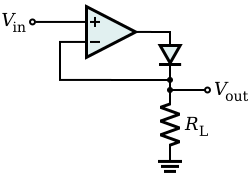
The voltage drop VF across the forward biased diode in the circuit of a passive rectifier is undesired. In this active version, the problem is solved by connecting the diode in the negative feedback loop. The op-amp compares the output voltage across the load with the input voltage and increases its own output voltage with the value of VF. As a result, the voltage drop VF is compensated and the circuit behaves very nearly as an ideal (super) diode with VF = 0 V.
The circuit has speed limitations at high frequency because of the slow negative feedback and due to the low slew rate of many non-ideal op-amps.
Logarithmic output
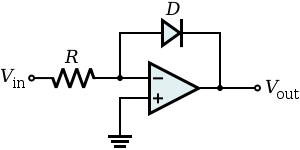
- The relationship between the input voltage Vin and the output voltage Vout is given by
- where IS is the saturation current and VT is the thermal voltage.
- If the operational amplifier is considered ideal, the inverting input pin is virtually grounded, so the current flowing into the resistor from the source (and thus through the diode to the output, since the op-amp inputs draw no current) is
- where ID is the current through the diode. As known, the relationship between the current and the voltage for a diode is
- This, when the voltage is greater than zero, can be approximated by
- Putting these two formulae together and considering that the output voltage is the negative of the voltage across the diode (Vout = −VD), the relationship is proven.
Exponential output

- The relationship between the input voltage and the output voltage is given by
- Considering the operational amplifier ideal, then the negative pin is virtually grounded, so the current through the diode is given by












































